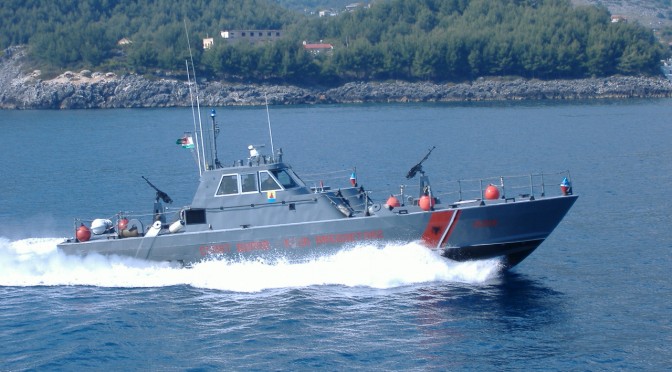The Republic of Albania, which joined NATO together with Croatia in 2009, has had an interesting relationship with its own maritime forces over the past two decades. Until the onset of economic crisis in 1996, the Albanian Naval Force consisted of approximately 145 vessels, many of which were obtained from China or the Soviet Union for the sole purpose of coastal defence. Illustrative of this focus on countering outside aggression, 45 of the Albanian Naval Force’s vessels were Huchuan-class torpedo boats manufactured in China.
With the onset of economic crisis in 1996, much of Albania’s maritime forces were decommissioned. Even prior to the collapse of the country’s communist regime in 1990-1991, the navy had entered a state of decline. The pride of the fleet – four Whiskey-class submarines obtained from Soviet benefactors – had essentially been mothballed by the end of the 1980s. Albania, despite its commanding position at the point where the Ionian Sea meets the Adriatic, had become a non-factor in naval affairs.
But the Albanian Naval Force has begun to experience a profound resurgence in recent years. Even prior to the country’s NATO accession, Albania committed in 2007 to participate in Operation Active Endeavour. This maritime operation is responsible for monitoring traffic in the Mediterranean Sea, intercepting illicit arms or narcotics shipments and enhancing the security of legitimate shipping in general. Since joining NATO, Albania has ramped up the modernization and expansion of its maritime forces as well. Whereas the People’s Socialist Republic of Albania once deployed sleek torpedo boats and predatory Soviet submarines in its defence, the Republic of Albania is actively acquiring patrol vessels to police Albanian waters and combat organized crime groups.
The mainstay of the new Albanian Naval Force is the Damen Stan 4207 patrol vessel, designed in the Netherlands but built for the most part in Albania. As of 2013, four vessels of this class are now in service on Albania’s coasts. It is worth noting that this design was the inspiration for the Canadian Coast Guard’s own Hero-class mid-shore patrol vessel, and that 35 vessels of the Damen Stan 4207 design are currently operated by 13 countries. The Albanian Naval Force backs up these four quality patrol vessels with an additional 27 vessels of various classes, most of which are patrol boats obtained from either the United States or the Italian Coast Guard.
But why is Albania dedicating so much of its resources toward the development of its maritime forces? The total cost of procuring the four Damen Stan 4207 patrol vessels is estimated to have been $45 million alone. The reason for this significant investment may be South Eastern Europe’s growing role as both a source of, and a transit point in, the trade of illicit narcotics. According to the United Nations Office on Drugs and Crime (UNODC), Albania has emerged as the fourth most common country of provenance for heroin, behind only Afghanistan, Pakistan, and Tajikistan. Lazarat, located in the far south of Albania, has emerged as one of Europe’s most significant centres for cannabis cultivation and the production of such cannabis-related products as hashish. Another UNODC report estimates that Albania itself is home to only 3,000 to 5,000 injection drug users, indicating that heroin entering Albania is hardly meant to remain there. Rather, the 2012-2015 UNODC Regional Programme for South Eastern Europe pegs the market value of heroin trafficked from this region to Western Europe at approximately $13 billion a year.
While some quantity of cocaine, heroin, and cannabis may take a circuitous route by land through Albania, Montenegro, and other South Eastern European countries until it reaches the territory of European Union member states, Albania’s geographic position opens up other options. The Albanian city of Vlorë is less than 100 kilometres from the Italian port of Otranto, separated only by the narrow strait that lies between the Ionian and the Adriatic proper. There are likely other sea routes which can be employed by organized crime. The Albanian Naval Force of the past would have not been well-disposed toward the interception of criminal elements transporting narcotics between these ports and others. But new patrol vessels have enhanced Albania’s capacity to address this security challenge and, with the enhanced cooperation NATO membership brings, Albania is better able to coordinate patrols and interdictions with its Italian partners.
The substantial increase in drug seizures along Albania’s coasts since 2006 is a positive sign. There is still some room for improvement in the area of inter-agency cooperation, however. On the eve of its NATO accession, Albania established an Inter-institutional Maritime Operations Centre (IMOC), intended to foster close cooperation between the Defence and Interior Ministries (as well as military and law enforcement personnel by extension). As noted in a recent review of Albania’s National Security Strategy though, IMOC has thus far been constrained by overlapping legislation and bureaucratic friction. Reforming the Albanian Maritime Code and other relevant aspects of the country’s legal framework may be necessary to ensure the efficiency and efficacy of Albania’s maritime operations.
Fortunately, the momentum is with the Albanian Naval Force in the struggle against regional narcotics trafficking. Continued support from NATO and its member states will further discourage organized crime, ending the exploitation of this proud country as a transit point for harmful drugs.
This article was originally published by the NATO Council of Canada.
Paul Pryce is a Junior Research Fellow at the Atlantic Council of Canada. With degrees in political science from universities in both Canada and Estonia, he has previously worked in conflict resolution as a Research Fellow with the OSCE Parliamentary Assembly. His research interests include African security issues and NATO-Russia relations.

